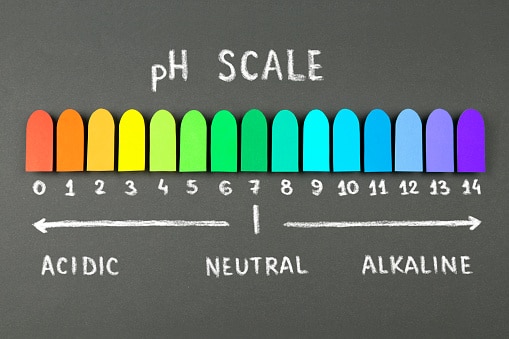Beer is an alcoholic beverage produced by the fermentation of starch and most modern beers are brewed with hops. Beer is also one of the most common types of alcohol, and the ph of beer needs to be monitored for safe consumption by people.

Main ingredients of beer
- Water: Water is the most important ingredient in beer, making up about 90% of the volume. The quality of the water used to make beer can have a significant impact on the flavor of the beer.
- Grain: The grain used to make beer is most commonly malted barley, but other grains such as wheat, rye, and corn can also be used. The grain is malted by soaking it in water and then allowing it to germinate. This process converts the starches in the grain into sugars.
- Hops: Hops are flowers that are added to beer during the brewing process. Hops add bitterness, flavor, and aroma to beer.
- Yeast: Yeast is a living organism that ferments the sugars in the wort (the liquid that results from mashing the grain) to produce alcohol and carbon dioxide.
The proportions of these ingredients vary depending on the type of beer being made. For example, stouts and porters are typically made with roasted barley, which gives them a darker color and a more intense flavor. Lagers are fermented at a lower temperature than ales, which gives them a cleaner, crisper flavor.
pH value of beer
In order for a person to be able to drink beer safely, ph is one of the measurement indicators.
The pH of beer is typically between 4.0 and 4.6 (A20 Water pH ORP Controller can be used to measure ph), which means that it is slightly acidic. The acidity of beer is due to the presence of organic acids, such as lactic acid and acetic acid, which are produced by the yeast during fermentation. The pH of beer can also be affected by the type of water used in brewing, the type of malt used, and the brewing process.

A lower pH in beer can lead to a harsher taste, while a higher pH can lead to a bland taste.
Why measure the pH value of beer?
- To ensure the quality of the beer: The pH of beer can affect the flavor, stability, and shelf life of the beer. By measuring the pH, brewers can ensure that the beer is of high quality and will last for the desired amount of time.
- To troubleshoot brewing problems: If the pH of the beer is too high or too low, it can cause problems with the brewing process. For example, a high pH can lead to bacterial growth, while a low pH can lead to a harsh taste. By measuring the pH, brewers can troubleshoot brewing problems and improve the quality of the beer.
- To adjust the pH of the beer: If the pH of the beer is not within the desired range, it can be adjusted by adding acids or bases. By adjusting the pH, brewers can create a beer with the desired flavor and stability.
pH values for different types of beer
| Type of Beer | PH Value |
| Lager | 4.2-4.4 |
| Ale | 4.0-4.2 |
| Stout | 3.8-4.0 |
| Porter | 3.6-3.8 |
| Wheat Beer | 4.4-4.6 |
| Saison | 4.2-4.4 |
| Sour Beer | 3.4-3.6 |
As you can see, the pH values of different beers can vary by up to 0.2. This is because the brewing process and the ingredients used can affect the acidity of the beer. For example, lagers are typically fermented at a cooler temperature than ales, which results in a lower pH. Additionally, wheat beers often contain more malted wheat than other types of beer, which can also lead to a lower pH.

The pH of beer can also affect the flavor of the beer. A lower pH can lead to a more tart or sour flavor, while a higher pH can lead to a more bland or watery flavor. The ideal pH for beer is subjective, but most brewers agree that a pH of between 4.2 and 4.4 will result in a balanced and flavorful beer.
How to monitor beer pH?
If you are interested in brewing your own beer, it is important to measure the pH of the wort (the liquid before fermentation) to ensure that it is within the desired range. You can use a pH meter or pH paper to measure the pH. If the pH is too high or too low, you can adjust it by adding acids or bases.
There are a few ways to monitor the pH of beer. One way is to use a pH meter. A pH meter is a device that measures the acidity or alkalinity of a solution. Apure’s A10 Aquarium ORP pH Controller can be used to measure.

To use a pH meter, simply dip the probe into the beer and take a reading. The reading will be displayed on the meter. The ideal pH for beer is between 4.5 and 5.5.
Another way to monitor the pH of beer is to use pH test strips. pH test strips are strips of paper that have been impregnated with a pH indicator. When the strip is dipped into the beer, the color of the strip will change depending on the pH of the beer. The color can then be compared to a chart to determine the pH of the beer.
pH test strips are less accurate than pH meters, but they are more convenient and less expensive.
Finally, the pH of beer can also be monitored by taste. The more acidic the beer, the tarter it will taste. The less acidic the beer, the sweeter it will taste.
The pH of the different processes of brewing beer
It is important to monitor the pH of beer during the brewing process. The pH of the wort (the liquid that results from mashing the grain) can affect the flavor and stability of the beer. The pH of the wort should be between 5.2 and 5.6.

The pH of the beer can also change during fermentation. The yeast will produce acids as they ferment the sugars in the wort. This can cause the pH of the beer to drop. The pH of the beer should be between 4.5 and 5.5 at the end of fermentation.
If the pH of the beer is too high or too low, it can affect the flavor and stability of the beer. For example, a beer with a pH that is too high may be sweet and flabby, while a beer with a pH that is too low may be tart and sour.
Brewers can control the pH of beer by using different ingredients, brewing processes, and storage conditions. For example, using hard water can increase the pH of the beer, while using soft water can decrease the pH of the beer. Using roasted malts can also increase the pH of the beer.
Brewers can also control the pH of beer by adding acids or bases to the wort or beer. Acids such as lactic acid and phosphoric acid can be added to lower the pH of the beer, while bases such as baking soda can be added to raise the pH of the beer.
Monitoring the pH of beer is an important part of the brewing process. By monitoring the pH, brewers can ensure that their beer has the desired flavor and stability.
How to store beer?
- Store beer in a cool, dark place. The ideal temperature for storing beer is between 45 and 55 degrees Fahrenheit. Storing beer in a warm environment can accelerate the aging process and cause the beer to lose its flavor. Storing beer in a light environment can cause the beer to skunk.
- Store beer upright. This will help to prevent the yeast from settling on the bottom of the bottle or can.
- Do not store beer in the refrigerator for an extended period of time. While the cold temperature will help to preserve the beer, it can also cause the beer to lose its carbonation.
- If you are storing beer for an extended period of time, consider aging it. Aging beer can improve the flavor of the beer. However, not all beers are suitable for aging. It is important to research the specific beer to determine if it is suitable for aging.
Is beer good or bad for human body?
Beer can be both harmful and beneficial to the human body, depending on how much is consumed.
In moderation, beer has been shown to have some health benefits, including:
- Reduces the risk of heart disease. Studies have shown that moderate beer consumption can help reduce the risk of heart disease by increasing levels of good cholesterol and reducing levels of bad cholesterol.
- Protects against cancer. Beer contains antioxidants that can help protect cells from damage that can lead to cancer.
- Improves bone health. Beer contains silicon, which is a mineral that is important for bone health.
- Boosts the immune system. Beer contains B vitamins, which are important for the immune system.
- Improves brain function. Beer contains folate, which is a vitamin that is important for brain function.
However, excessive beer consumption can lead to a number of health problems, including:
- Alcohol poisoning. This can occur when a person drinks too much alcohol in a short period of time. Symptoms of alcohol poisoning include vomiting, seizures, and loss of consciousness.
- Liver damage. Alcohol is toxic to the liver, and excessive alcohol consumption can lead to liver damage, including cirrhosis.
- Heart disease. Excessive alcohol consumption can increase the risk of heart disease, including heart attack and stroke.
- Cancer. Excessive alcohol consumption has been linked to an increased risk of certain types of cancer, including breast cancer, colorectal cancer, and liver cancer.
- Brain damage. Excessive alcohol consumption can damage the brain and lead to problems with memory, thinking, and judgment.
- Fetal alcohol spectrum disorders. Women who drink alcohol during pregnancy can put their babies at risk for fetal alcohol spectrum disorders (FASDs), a group of conditions that can cause physical and mental birth defects.
It is important to note that the amount of alcohol that is considered “moderate” varies from person to person. The Centers for Disease Control and Prevention (CDC) defines moderate alcohol consumption as up to one drink per day for women and up to two drinks per day for men. A drink is defined as 12 ounces of beer, 5 ounces of wine, or 1.5 ounces of hard liquor.
If you are considering drinking beer, it is important to do so in moderation and to be aware of the potential risks associated with excessive alcohol consumption.
Summary
Overall, lower and higher ph levels can affect the flavor and taste of beer, and are also beneficial to health in moderation. PH Controller & Sensor from Apure can effectively measure ph in beer or more applications. With more than 16 years of instrumentation experience, Apure has developed into a leading instrumentation manufacturer in China and provides one-stop service to customers worldwide. Apure also provides various water quality monitoring instruments such as conductivity, dissolved oxygen, residual chlorine, turbidity, salinity, multi-parameter, etc., please feel free to contact us.
Extended reading:
Symptoms Of Low pH In Fish Tank
3 Main Water Quality Parameters Types
How To Remove Chlorine & Chloramine From Water?
Distilled Water vs Purified Water
